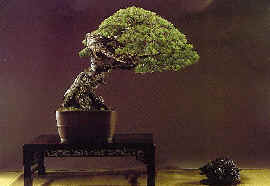| Bonsai
is the traditional Japanese Art of appreciating the beauty of nature in
intentially dwarfed potted trees. The wish to enjoy living plants - their
growth, their beautiful flowers, fruits and leaves - as closely as possible
is common to people throughout the world. The Japanese have expressed this
wish in creating the art of bonsai. The literal meaning of bonsai is "potted
plant". But Bonsai is more than just a potted plant: It is the attempt
to represent nature itself in a small pot. A bonsai conveys the impression
of an old huge tree, a forest or a landscape in nature. It is a miniaturized
reproduction of anture, but at the same time a living tree. Nurturing such
a small piece of nature over many years can become a source of pleasure
and recreation.
The art of bonsai has a long tradition and bonsai
have been cultivated in Japan over many centuries. Paintings of bonsai
can already be found in picture scrolls of the Kamakura period (1192 -
1333). Some of the bonsai, which were cultivated in the Edo period (1603
- 1867) about two or three centuries ago, are even still alive today.
Bonsai is appreciated today
not only in Japan, but also in many other countries as a "living
art", which has not only form but also spirit. More and more people
around the world are discovering its beauty and find pease of mind in
this fascinating hobby. We hope the "spirit of bonsai" will
become a symbol of peace.
|

Pinus pentaphyllus var. Himekomatsu
Height / 70 cm (27.5 in.) Age / 500 years |
